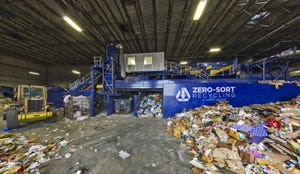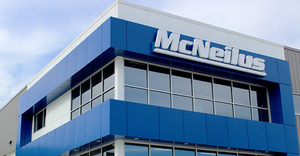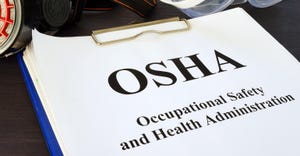Revving Up
Industry prepares for tougher truck-engine emission standards in 2010.

With the federal government's 2010 truck emission mandates looming, refuse truck fleets need to start thinking about exhaust control technology.
Every diesel engine maker and truck manufacturer except Warrenville, Ill.-based Navistar Corp. is planning to use selective catalytic reduction (SCR) technology to reduce the amount of nitrogen oxides (NOx) given off in the exhaust stream down to the required level — 0.2 grams per brake horsepower hour(g/bhp-hr), a truly miniscule amount.
Navistar, on the other hand, will use what it calls advanced exhaust gas recirculation (advanced EGR) to cut NOx emissions from its MaxxForce brand of diesel engines down to the required level.
All heavy-duty diesel engines, except for those built by Peoria, Ill.-based Caterpillar, use EGR. It's just that Navistar's product line will use more of it, along with higher fuel injection pressures and other measures, to reach the required level. Caterpillar found the technology investments to make its truck engines compliant with the 2010 federal emission regulations too expensive, so it's exiting the truck engine market.
Mike Delaney, senior vice president of marketing for Portland, Ore.-based Daimler Trucks North America (DTNA), which builds Freightliner-brand trucks and also owns engine maker Detroit Diesel Corp. (DDC), Redford, Mich., says the biggest benefit of SCR is improved fuel economy. Exactly how much improvement a fleet can expect remains to be seen, but "if an engine system can deliver even a 1 percent or 2 percent increase in fuel economy, it would save a significant amount in diesel," says Jeff Jones, vice president of sales and marketing for Columbus, Ind.-based engine maker Cummins Inc.
"Depending on the cost of diesel fuel, you could expect a return on the SCR technology in less than three years with fuel savings alone," says David McKenna, powertrain sales and marketing manager for Greensboro, N.C.-based Mack Trucks, which is owned by Sweden's Volvo AB and aligned with Volvo Trucks North America, also based in Greensboro.
However, according to a study by New York-based NERA Economic Consulting and supported by Navistar, 2010-compliant Class 8 trucks using SCR systems could cost $7,000 to $10,000 more than today's vehicles. Engine makers using SCR dispute those numbers, but they do admit price increases for SCR-equipped trucks are inevitable. Bernard Heil, Daimler's VP of truck product engineering powertrain, noted that SCR added some $4,000 to the cost of European commercial trucks.
Even though SCR reduces diesel fuel consumption, it requires diesel exhaust fluid (DEF), which is made from the liquid ammonia compound urea, to be sprayed into the tailpipe in order to do so. Furthermore, Navistar says DEF won't be cheap.
"We believe urea is a secondary fuel that will have a cost that will be at least as much as diesel," says Bob Carso, director of global brand strategy for Navistar's engine group. "We have data showing, at the retail level, it's extremely expensive. We have paid $19.04, including tax, for a half-gallon of DEF in a packaged scenario."
Those engine OEMs using SCR, however, say DEF costs won't be anywhere near that expensive. In a recent truck emissions forum hosted by the Environmental Protection Agency (EPA), both Volvo and Mack stated that DEF should cost about $2.70 per gallon — and, with roughly two or three gallons of DEF required per 100 gallons of diesel fuel consumption, the costs should be minimal for truck fleets.
Day-to-Day
How will 2010 emissions technology affect refuse fleets on a day-to-day level? In terms of operating trucks, not much is going to change with either SCR or advanced EGR systems. In terms of maintenance, however, SCR will require new systems on the vehicles that will need close observation and that will also extend the service interval for other emission-control components, especially the diesel particulate filter (DPF) that collects the soot produced by the diesel combustion process.
SCR users say it actually takes very little DEF to reduce NOx emissions, with a 17- to 20-gallon tank of DEF covering about 5,000 to 6,000 miles of typical highway driving or two weeks of standard stop-and-go vocational truck operation.
"We're using less DEF than we thought, and we've reduced demand for active regeneration by 80 percent to 100 percent in some cases," McKenna says.
"Active regeneration" describes a process whereby soot particles collected by the DPF are burned off at high temperatures, a process that requires fuel and thus leads to lower fuel economy. McKenna says that using SCR allows engine makers to increase the temperature of the engine's combustion cycle, reducing soot particles. Though more NOx is created from higher engine combustion temperatures, the NOx is removed from the exhaust stream via the SCR technology.
"As a result, we're seeing up to an 18 percent improvement in fuel economy depending on the duty cycle compared to our 2007-engine package," McKenna says.
What does that mean in the real world? An 18-month test of a Mack Granite vocational chassis equipped with 2010 emission controls logged 5.4 miles per gallon across its daily duty cycle — loaded and unloaded, at highway speed and in stop-and-go traffic, he points out — almost a half mile to a mile per gallon better than current models under the same conditions.
McKenna also claims that SCR is going to allow engine makers using the technology to increase available horsepower without sacrificing fuel economy.
The DEF Question
One concern with SCR technology is how DEF reacts to extreme temperatures. McKenna says DEF comprised of 32 percent urea (the standard amount) is not going to significantly degrade in extreme heat, such as when the thermometer hits 120 degrees Fahrenheit (F) during the summer in Arizona, nor freeze solid in a Minnesota cold snap.
"DEF will 'slush' at around 11 to 12 degrees F and will 'wax' at minus 12 degrees F," McKenna says. "However, most on-chassis DEF tanks will have an internal heating system and heated supply lines from the tank to the injector, so no problem there."
"When the ignition key is turned off, the DEF supply pump returns all the unused fluid back into the tank so the supply lines do not freeze up," McKenna adds. "At the base of the DEF pick-up tube is a small heating element that will thaw a small amount of DEF for immediate use. Remember, a very cold engine produces very little NOx — almost none. So far, in three years commercial service in the [European Union] and Scandinavia, there has been no complaint of DEF freezing to a point that the on-chassis heat systems could not deal with."
However, in much warmer weather — the aforementioned 120 degrees F — DEF could possibly degrade over time. "The key word here is 'time,'" McKenna says. "Are we talking a few days or a week or two? In that period of time there would be somewhere between zero and negligible quality degradation. From [our] field testing you would need to leave the DEF fully exposed for several months to measure degradation."
The Advanced EGR Path
While advanced EGR doesn't offer the fuel economy improvement SCR does, Tim Shick, director of marketing with Navistar's engine group, says it should at least be "fuel neutral" and will not require the extra gear — DEF, a DEF tank, catalyst, hoses, sensors — needed to make SCR function. Those items can add up to 400 extra pounds to a truck chassis.
Navistar says the advanced EGR system will meet the 2010 regulations by increasing the amount of exhaust gas recirculated into the cylinder by about 10 percent and boosting fuel injection pressures to around 35,000 pounds per square inch to increase engine efficiency.
Shick adds that Navistar is going to upgrade its engine cooling system to handle the increased heat generated by the advanced EGR process. One caveat is that Navistar plans to ramp its way up to federal 2010 emission levels by cashing in federal credits it collected from the EPA by exceeding previous emissions requirements. That means the engines it builds after Jan. 1, 2010 will not meet the 0.2 g/bhp-hr standard right away. Rather, they will gradually meet those standards over several years.
Again, though, Shick insists Navistar's engines should be very competitive when it comes to total cost of ownership, because while SCR engines can "dial back" EGR levels to optimize fuel-efficiency, they end up using the same overall amount of fluid as EGR-only engines. By doing this, they are trading lower diesel fuel use for higher DEF consumption.
Still, there will be a cost upgrade associated with advanced EGR engines — Navistar hasn't revealed how much yet — largely to cover the investment in the new high pressure fuel injection system along with using lighter yet stronger compacted-graphite iron material to build its engine blocks.
HOW IT WORKS
Sean Kilcarr is a senior editor of Fleet Owner, a sister publication of Waste Age.
For more stories on waste fleets, visit the Trucks & Bodies section.
HOW IT WORKS
SCR
Selective catalytic reduction (SCR) injects diesel exhaust fluid (DEF) into an engine's hot exhaust stream to reduce emissions of nitrogen oxides (NOx). DEF is a water-based solution comprised of 32.5 percent urea and 67.5 percent de-ionized water. The solution, in conjunction with a catalyst material called copper zeolite, breaks down the NOx into harmless nitrogen and water vapor. Urea is an organic nitrogen-containing compound commonly used in agriculture as a fertilizer and is classified by the U.S. Environmental Protection Agency as a nonhazardous substance.
EGR
Depending on engine operating conditions, exhaust gas recirculation (EGR) systems divert 5 percent to 30 percent of an engine's exhaust stream through an air-to-water cooler and then re-introduce the exhaust air back into the combustion chambers to both retard nitrogen oxide (NOx) formation as well as burn off particulate matter. All EGR engines use coolant to reduce exhaust temperature from around 1,100 degrees Fahrenheit (F) to 300 degrees F. Cooled exhaust gases are channeled to a mixer, which ensures that intake air and gases are thoroughly blended before reaching the engine's cylinders.
Advanced EGR
Advanced exhaust gas recirculation cuts nitrogen oxide (NOx) emissions in a diesel engine's cylinder without increasing the amount of particulate matter (PM) generated by significantly raising fuel injection pressures at low engine speeds (as low as 800 revolutions per minute). Higher injection pressure increases the surface area of the fuel, leading to a more efficient burn that prevents PM from forming. Multiple injection events at those low speeds and high pressure rates — as many as five in a single combustion stroke — also create a smoother combustion event that helps further retard NOx generation. Other key elements in Navistar's 2010 emissions strategy include modifying turbocharger rates, optimizing combustion with a redesigned piston bowl and careful calibration of electronic engine controls.
The Cleaner Air Timeline
The truck emission regulations have come in stages. In October 2002, the Washington-based U.S. Environmental Protection Agency (EPA) required new heavy-duty diesel engines to emit no more than 0.1 grams per brake horsepower hour (g/bhp-hr) of particulate matter (PM), 2 g/bhp-hr oxides of nitrogen (NOx), and between 0.4 and 0.5 g/bhp-hr of non-methane hydrocarbons (NMHC). The NOx and NMHC measurements typically were combined for testing at 2.5 g/bhp-hr. In 2004, the rules were expanded to include medium- and light-duty diesel truck engines.
In 2007, PM emission requirements decreased to 0.01 g/bhp-hr, NOx to 0.2 g/bhp-hr and NMHC to 0.14 g/bhp-hr. The PM requirement was implemented fully in 2007, while the EPA has allowed the NOx and NMHC requirements to be phased-in.
The phase-in will be final next year, and new diesel engines in 2010 will produce less than 10 percent of the emissions of 2001 models.
About the Author
You May Also Like


